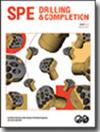Challenges and Potentials for Sand and Flow Control and Management in the Sandstone Oil Fields of Kazakhstan: A Literature Review
IF 1.2
4区 工程技术
Q3 ENGINEERING, PETROLEUM
引用次数: 1
Abstract
Kazakhstan owns one of the largest global oil reserves (approximately 3%). This paper aims at investigating the challenges and potentials for production from weakly consolidated and unconsolidated oil sandstone reserves in Kazakhstan. We used the published information in the literature, especially those including comparative studies between Kazakhstan and North America. Weakly consolidated and unconsolidated oil reserves in Kazakhstan were studied in terms of the depth, pay-zone thickness, viscosity, particle-size distribution (PSD), clay content, porosity, permeability, gas cap, bottomwater, mineralogy, solution gas, oil saturation, and homogeneity of the pay zone. The previous and current experiences in developing these reserves were outlined. The stress condition was also discussed. Furthermore, the geological condition, including the existing structures, layers, and formations, were addressed for different reserves. Weakly consolidated heavy-oil reserves in shallow depths (less than 500-m true vertical depth) with oil viscosity of approximately 500 cp and thin pay zones (less than 10 m) have been successfully produced using cold methods; however, thicker zones could be produced using thermal options. Sand management is the main challenge in cold operations, while sand control is the main challenge in thermal operations. Tectonic history is more critical compared with the similar cases in North America. The complicated tectonic history necessitates geomechanical models to strategize the sand control, especially in cased and perforated completions. These models are usually avoided in North America because of the less-problematic conditions. Further investigation has shown that inflow-control devices (ICDs) could be used to limit the water breakthrough, because water coning is a common problem that begins and intensifies the sanding. This paper provides a review on challenges and potentials for sand control and sand management in heavy-oil reserves of Kazakhstan, which could be used as a guideline for service companies and operators. This paper could be also used as an initial step for further investigations regarding the sand control and sand management in Kazakhstan.哈萨克斯坦砂岩油田防砂防流管理的挑战与潜力:文献综述
哈萨克斯坦拥有全球最大的石油储量之一(约占3%)。本文旨在调查哈萨克斯坦弱固结和松散油砂岩储量开采的挑战和潜力。我们使用了文献中已发表的信息,特别是哈萨克斯坦和北美之间的比较研究。从产层的深度、产层厚度、粘度、粒度分布(PSD)、粘土含量、孔隙度、渗透率、气顶、底水、矿物学、溶解气、含油饱和度和均匀性等方面研究了哈萨克斯坦的弱固结和松散石油储量。概述了以往和目前开发这些储量的经验。并对应力条件进行了讨论。此外,对不同储量的地质条件,包括现有结构、地层和地层进行了处理。浅层(实际垂直深度小于500米)的弱固结稠油储量,原油粘度约为500厘泊,薄油层(小于10 m) 已使用冷法成功生产;然而,使用热选项可以产生较厚的区域。防沙是冷作业中的主要挑战,而防沙是热作业中的最大挑战。与北美的类似情况相比,构造史更为关键。复杂的构造历史需要地质力学模型来制定防砂策略,尤其是在套管和射孔完井中。这些模型在北美通常被避免,因为那里的条件问题较少。进一步的调查表明,流入控制装置(ICD)可以用来限制水的穿透,因为水锥进是一个常见的问题,会开始并加剧出砂。本文综述了哈萨克斯坦稠油储量防砂和防砂管理面临的挑战和潜力,可为服务公司和运营商提供指导。本文也可作为进一步调查哈萨克斯坦治沙和治沙的初步步骤。
本文章由计算机程序翻译,如有差异,请以英文原文为准。
求助全文
约1分钟内获得全文
求助全文
来源期刊

SPE Drilling & Completion
工程技术-工程:石油
CiteScore
4.20
自引率
7.10%
发文量
29
审稿时长
6-12 weeks
期刊介绍:
Covers horizontal and directional drilling, drilling fluids, bit technology, sand control, perforating, cementing, well control, completions and drilling operations.
 求助内容:
求助内容: 应助结果提醒方式:
应助结果提醒方式:


